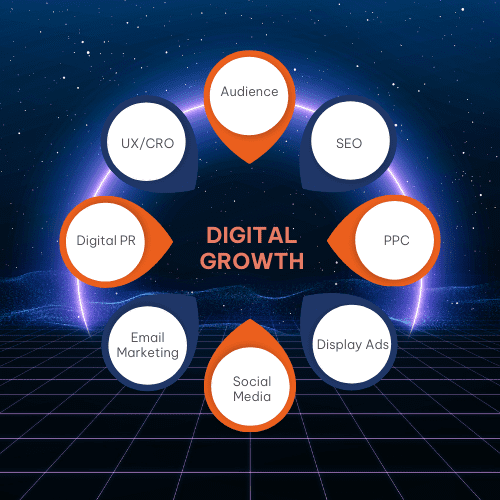How To Craft a Powerful Digital Growth Strategy





By Jade Hallam
Managing Director
With over a decade of experience in digital marketing, Jade has partnered with countless brands to develop comprehensive strategies. She brings expertise across all areas of digital, but her specialism shines in SEO and Digital Strategy.
24 January 2024
Blog Digital StrategyCreating a digital strategy is the key to unlocking online success. Whether you’re a brand new company or a multi-million pound enterprise, creating a digital growth strategy is essential for gaining and retaining customers. Lots of companies and digital agencies alike neglect the crucial integration of thorough planning into their digital marketing activities, meaning opportunities are lost.
Strategic planning is important when trying to achieve sustainable growth. To obtain optimal growth, these strategies must be not only targeted but also thoughtfully distributed across various digital channels.
Irrespective of your industry there will always be one competitor who has fully embraced the potential of their digital strategy. The only way to triumph is to craft a superior strategy, carving a distinctive niche in your industry.
Digital growth refers to the improvement of your website’s key performance indicators based on digital marketing activities. A well-executed digital growth strategy would increase metrics including:
If you’re trying to build brand awareness, increase your customer base and boost your online visibility, then a digital growth strategy is going to be paramount to achieving your business objectives.

The first step of any successful digital marketing strategy is to work out who you’re trying to reach. You’re aiming to find people who are interested in your products or services, however, this is often broken down into customer profiling traits. Traits such as gender, age group, income and interests can often help to create a brand persona.
Using existing data not just from your website, but your competitor’s websites, can help to figure out where your target audience sits for each of these traits. There are several paid tools you can use to easily profile the users who are most engaged with your industry. One example is SEMRush One2Target, as part of their trends toolkit you can add up to 5 competitor domains and view key metrics such as:
Putting all this data together with any other information you’ve already collected can give you a thorough understanding of the types of users that you need to be targeting.

SEO is constantly evolving, meaning staying on top of the latest trends and best practices can be difficult. There are however some core SEO techniques that remain relevant throughout all the changes:
Each page on your website should have a unique meta title containing the most relevant and high-value keyword that you’re trying to rank for. Meta titles should be 50 – 60 characters long to ensure Google doesn’t cut it off in the SERPs. The meta description should give a snippet of information about the page’s content and entice users to click on your website. Meta descriptions should be set at 150 – 160 characters.
Your page content should be well-written and provide valuable information about your product or service. Avoid keyword stuffing and instead do keyword research to establish keyword variations that you can use. Don’t write content just for the sake of bulking up the word count, highlight important content to make it easier for users to find. Quality content is important, ensure that your content is accurate, original, easy to read and matches your brand’s tone of voice.
You can make your content easier to read and index by using heading tags in a hierarchy structure. Your page title/main keyword should be a H1, with subheadings using a H2 format. Any further information under each H2 that warrants its own section should be written as a H3 heading. When writing content you can create all your headings first to make sure it’s well-planned and covers your key points.
URLs are more important than you might think when it comes to how your website is structured. Using parent pages and well-optimised URLs not only helps users understand and navigate your website effectively, but it also helps crawlers to prioritise your content and key pages.
Inputting internal links helps users to easily navigate between relevant website pages, and also signal a link between these pages to search engines. Where possible use descriptive anchor text, such as the name of the other product/service rather than “find out more” or “click here”. You can also use images with links behind them to increase CTR in certain navigational sections of your website.
Rich content is becoming a much more important part of SEO, with pictures, graphics, videos and illustrations paving the way to higher rankings. Investing time and effort into creating visual content usually leads to more unique page views and shares. Don’t forget, when adding images and graphics to your website you should also add a descriptive ALT text, explaining the image.
Structured data and schema markup allow you to provide more information about a page or piece of content to search engines. Google can better understand your content and may rank it higher for certain keywords and phrases. Schema markup is extremely versatile, but some common markups you may consider implementing include: Product, article, event, organization, review, breadcrumbs, local business and video.
Making sure your website loads quickly has been a Google ranking factor since 2010 and is still just important in 2024. With the rise of Web Core Vitals, Google is still pushing for quick website load speeds, especially for mobile devices. Some quick win optimisation includes compressing images and minifying HTML and Javascript, which can be done using Plugins such as Hummingbird if you don’t have access to a web developer.
Technical SEO ensures that your website is properly crawled and indexed. There are several paid tools that can help you to identify technical SEO errors including Moz, SEMRush and AHrefs, amongst others. Using one of these tools gives you the ability to crawl your website and provides a comprehensive list of errors. You can then work through the list to make sure your website health is good and your website is easy to crawl, index and rank. You can also use free tools such as Google Search Console to identify which of your pages are indexed and any top-level errors.
Backlinks have long been rumoured to be one of Google’s most important search ranking factors. The reason for this is that Google sees high-quality, relevant backlinks from other authoritative websites as a trust signal. Whilst Google has always struggled to accurately understand and rank content, link signals were an easy way to assess the quality of a piece of content. The more people who share and link to a post, the better it must be. Building backlinks is essential, especially for new websites that are trying to build up their credibility. Bigger sites can build links naturally but should keep an eye on their backlink profile to ensure it’s not being spammed with links from low-quality websites.
If your business has a physical address and you want to attract customers in your local area, you need to be optimising for local search. Local search uses a targeted approach to reach potential customers in your local area. You need to create a profile on Google My Business, Bing Places and any other map providers. Make your profile as detailed as possible by adding your business information, pictures of your products or premises and direct users to your reviews section to build up your authority. You should also try to get listed in any other local directories and share company updates to your accounts as often as possible.
PPC is a fantastic tool for finding customers who are ready to buy your products or enquire about your services. By conducting in-depth research you can establish which users are at the end of the sales funnel, and leverage this data to gain customers. With the ability to A/B test campaigns, it’s possible to try out different campaign types and optimise them over time based on the data you receive.
Targeting the right keywords is essential for any successful PPC campaign. Using tools such as keyword planner, SEMRush or Ahrefs you can effectively target the right users who are ready to convert. It’s important to accurately assess the CPC (cost per click) and forecast your potential return on investment. Negative keywords are just as important as focus keywords, to ensure you’re not wasting ad spend on irrelevant search terms.
To create well-rounded ad copy for your campaigns you should consider adding:
Ad extensions are designed to add additional information to your ads, giving users extra navigation options directly from the SERPs. By utilising ad extensions you can increase your ad visibility and CTR. It’s best practice to include several variations of ad extensions to allow Google to serve them dynamically depending on the search query and user intent. Some extensions to consider adding include:
People seem to think that PPC is a quick-win channel, but like any digital marketing strategy, it will only become more profitable after ongoing data-led optimisation. Through Google Ads and Google Analytics, you have direct access to a wealth of information to optimise your campaigns. From the times your ads are served, to the best wording or imagery for conversions, you should be regularly monitoring and amending your campaigns to ensure they resonate with your target audience.
Visual ad types are growing in popularity. Providing rich content types is proven to resonate and draw in audiences and utilising Google Display Network placements is a great way to build brand recognition. Creating strong imagery that represents your brand and conveys your message is essential for conducting a successful display campaign.
Display ads allow for powerful audience targeting, with several options available. If your website has been running for a while with GA4 you can use custom audiences based on previous website users. This gives you a refined audience group with demographics similar to people who have previously engaged with your brand, giving you a headstart on your targeting. You can also create bespoke audiences based on third-party data and gradually refine it over time. Alternatively, you can use display ads for remarketing to recapture users who have landed on your website but have not performed a certain action, such as buying your product or enquiring about your services.
Measuring the effectiveness of your display advertising is much different than other paid media solutions. As a brand-building campaign, you shouldn’t be judging the success based only on direct conversions. You should use a mix of the following metrics to measure your campaign performance:

Social media is a brilliant tool for businesses of all sizes. What companies need to remember is that your target audience will always have a preferred social media platform. For example, there’s usually little to no value for a brand with a B2B offering to be focusing on Instagram, or a D2C brand investing heavily on LinkedIn. It’s important to finely tune your social offering to ensure the platforms you’re focusing on are the same ones your audience is likely to be using regularly.
Your content on social media should be focused on capturing your audience and nurturing your community. Resist the urge to flood your pages with product links. Think about it: who wants to follow a business page that’s a constant sales pitch? Take a look at your competitors’ social media strategies, identify their winning posts and see how you can incorporate similar posts into your strategy. As a rough recommendation only 15 – 20% of your overall posts should be conversion-led, such as sharing offers. The other types of content you should be focusing on are those that inspire, educate or engage users. This could be informative blog posts, rich content such as images or graphics, or engagement posts utilising features such as polls.
Brands that actively inspire engagement from their audience are usually the most successful on social media. Ask questions and encourage interactivity on your social posts. Respond to comments and be transparent, let your business persona shine, creating a connection that aligns users with your brand values.
Dive deeper into the social scene by adding strategic paid social ads into your strategy. Each platform offers different ad types designed for specific purposes. Experiment with low-cost ads, keeping a close eye on the results to fine-tune your strategy. Visuals matter, so invest time in creating eye-catching photos or videos. Remember, avoid merely boosting organic posts—this won’t give you the ROI you crave.
Email marketing is a low-cost, laser-focused marketing technique that all brands should be utilising. Imagine having a treasure trove of email addresses from your website users, forming a dedicated database of prospects ready to be nurtured and enticed.
The magic begins with data. The more you know about your email list members, the more tailored and impactful your emails can be. Imagine sending messages that feel like a one-on-one conversation, resonating with each recipient’s unique interests and preferences. It’s the secret sauce for maximum results.
Not every subscriber is the same, and that’s where segmentation steps in as the unsung hero. Break down your email list into segments based on demographics, interests, and order history. This way, each communication can be precisely targeted, ensuring your content reaches those most eager to engage. This helps to keep your open rates, click-through rates and conversion rates healthy.
Automation is a fantastic tool to ensure your subscribers receive the right email at the right time. Most email platforms come armed with powerful automation tools that let you choreograph your email delivery based on your subscribers’ actions. Whether it’s confirming a purchase, sending updates on delivery, or rekindling the interest of dormant subscribers with exclusive offers, automation is extremely versatile. Get creative with your workflows, experiment with A/B testing to find the sweet spot for wording and imagery, and watch your campaigns soar.
Digital PR is a dynamic marketing tool, wielding the dual benefits of building backlinks for SEO and establishing your brand’s credibility. Several key avenues within Digital PR can significantly amplify your digital presence.
Start your Digital PR journey by identifying influencers and industry leaders relevant to your niche. Connect on social media platforms, actively engage with their content, and initiate authentic interactions. Showcase your genuine connection by sharing their valuable content with your audience. Once the relationship is established, explore collaborations on content, events, or campaigns that offer mutual benefits. Consider investing in paid placements with influencers for an extended reach and heightened brand credibility.
Before seeking promotion, craft content that is not only valuable but also newsworthy and shareable. Develop compelling press releases and distribute them strategically to media, influencers, and relevant online platforms. Learn about your target audience, create connections, and understand the kind of content they resonate with. Leverage tools like Help A Reporter Out (HARO) to provide expert opinions, contributing to high-value placements and backlinks.
Using tools such as Google Alerts, you can monitor your brand mentions and check what people are saying about your company. You should respond promptly and professionally to both positive and negative feedback. Use any positive reviews to your advantage by sharing them on your website or social media, if you have a story to tell then go ahead and create an in-depth case study. Maintain a cohesive brand image across all online communications for enhanced recognition. Actively listen to customer feedback, use negative comments as constructive insights, and continually improve your offerings.
Digital PR is not just about visibility; it’s about cultivating lasting relationships, protecting your brand’s integrity, and crafting a narrative that resonates with your audience.
You’ve now attracted a bunch of users to your website through your multi-channel marketing efforts, but if their experience is subpar, it’s like throwing a party with bad music. After putting time and money into your digital growth strategy, your website should be the VIP lounge, not a confusing maze.
Identify testable elements on your website, such as heading tags, CTAs or buttons and content types (image vs video, graphic vs picture). Define goals and metrics for improvement, creating different variations for your landing pages. Implement A/B tests in a randomised manner to ensure unbiased and accurate results from your tests. Let your tests run their course for a solid period, ensuring statistically significant results before making conclusions. Based on test results, refine your website elements for ongoing improvements. It’s a perpetual cycle of refinement and enhancement.
Create customer surveys and feedback forms to find out directly from your users how they found your site experience. Place these forms strategically across your website and incorporate them into your email marketing strategy. Dive into heatmaps to understand user behaviour, revealing areas of high and low engagement. Keep an eye on social networks for indirect user feedback and gauge how users perceive your brand. Focus on feedback that provides actionable insights for immediate implementation and tangible results.
CRO and UX go hand in hand, guiding users through a seamless journey towards that final goal—conversion. Regular audits, A/B testing, and user feedback analysis are the secret ingredients for a website that’s not just user-centric but continually evolving to meet and exceed user expectations. It’s not just about clicks; it’s about creating an online experience that leaves users not just satisfied but eager to convert.

Digital growth isn’t just a plan, it’s the blueprint for online success. You might not be in a position to fully utilise every digital channel just yet but fear not. Crafting a multi-channel approach is your ticket to digital marketing greatness.
Picture this: all your marketing channels work together, harmonising to capture and nurture the hearts of your target audience. It’s not just a strategy; it’s a digital symphony designed for optimal results.
SEO isn’t just a buzzword; it’s the unsung hero that ties all your digital efforts together. In the grand orchestra of digital growth, every channel plays a crucial role, and SEO is the glue that keeps the rhythm flowing.
Remember, a marketeer’s job is never done. The digital landscape is ever-changing and will require continuous adaptation to grow your brand and stay on top of your industry. Your strategies should be agile and adjustable depending on emerging trends and audience behaviours.
Data plays a significant role in guiding your optimisation decisions, so regularly evaluate your performance using analytics and third-party tools. It’s not just about trends; it’s about staying ahead of the curve. Encourage innovation, explore new technologies, and embrace fresh opportunities and tactics that set your brand apart.
Growing revenue online is not a sprint; it’s a marathon. Brand credibility and authority are your trusty companions on this journey. Adopt a user-centric approach, delivering value that echoes and forms lasting relationships.
Feeling inspired? Ready to bring your digital growth strategy to life? Clever Clicks are here to make the magic happen. With proven success across all digital channels, we’re eager to set you on a roadmap to online triumph. Ready to kickstart your digital journey? Get in touch with us today to kickstart your journey to online growth.

Discover the top digital marketing trends set to shape 2026 from AI-driven personalisation to immersive content and evolving SEO strategies. Stay ahead of the curve.
Read full blog
SEO vs GEO: The Future of Search Optimisation
Read full blog